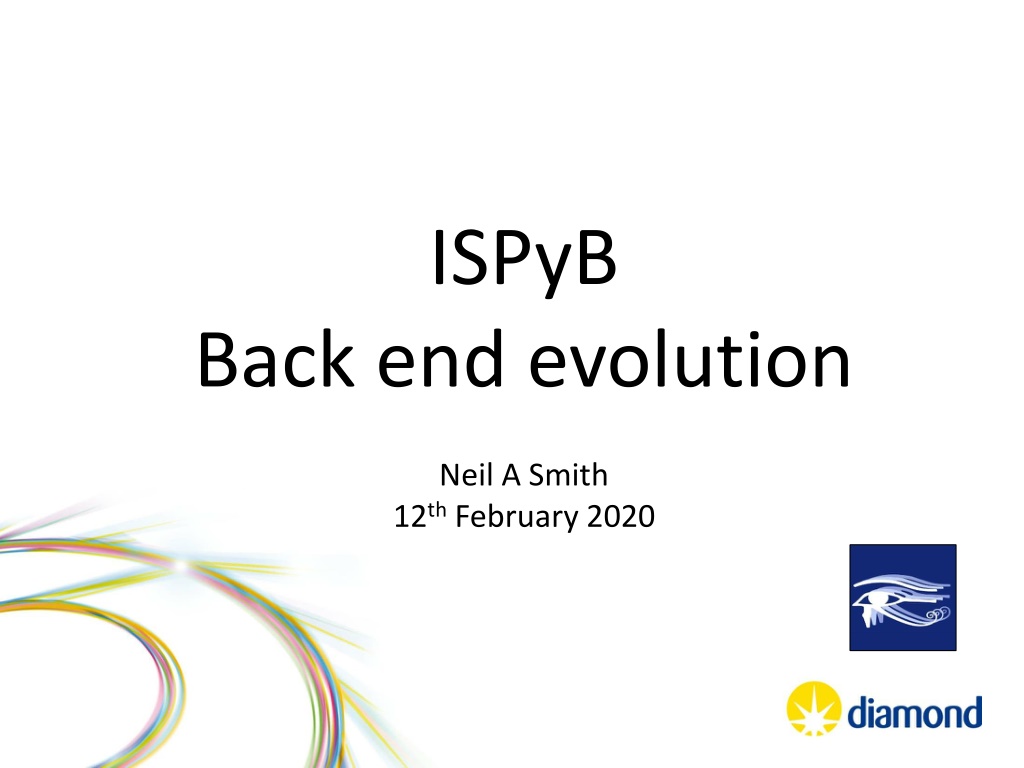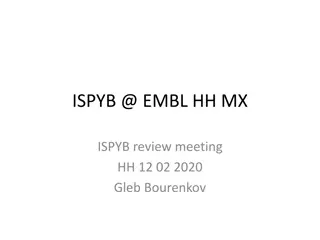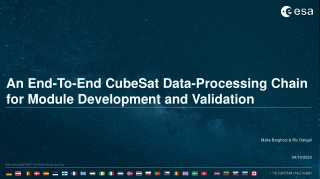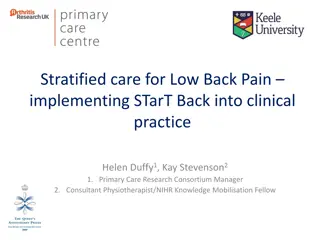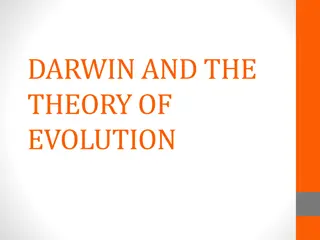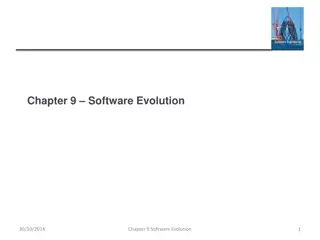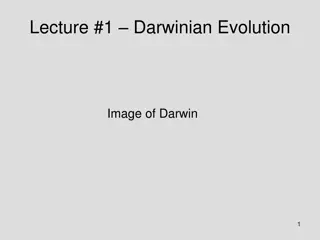ISPyB Back-End Evolution Overview
The ISPyB steering committee tasked developers with studying alternatives for evolving the current database and backend or starting fresh. Key considerations include technical options, resource levels across sites, and a shared vision for the future to enhance ISPyB's capabilities and efficiency. The focus is on evolving current services, potential new approaches, and collaboration within the community to improve Experiment Information Management System at DLS and beyond.
Download Presentation

Please find below an Image/Link to download the presentation.
The content on the website is provided AS IS for your information and personal use only. It may not be sold, licensed, or shared on other websites without obtaining consent from the author. Download presentation by click this link. If you encounter any issues during the download, it is possible that the publisher has removed the file from their server.
E N D
Presentation Transcript
ISPyB Back end evolution Neil A Smith 12th February 2020
Contents Current Landscape Future Landscape Database Services
ISPyB Steering committee request [developers] tasked with studying the alternatives of evolving the current data base and backend, or making a fresh start and rewriting, and present the alternatives with pros and cons at the review meeting.
ISPyB Collaboration Software stack Software stack Database schema Database schema EXI UI SynchWeb UI ISPyB ISPyB Java Web Services SynchWeb Services Scope of collaboration Outside collaboration but within community
Resource levels limited across sites Site ISPyB FTEs Comments DLS ~ 3.5 From March 2020 ESRF ~ 1.5 SOLEIL ~ 0.5 ALBA ~ 0.5 MAXIV ~ 0.5 HZB ? Global Phasing ? EMBL ~ 0.5 Elletra ~?
Technical Options Database Evolve what we have New approach NoSQL? Time series db? Nexus based? Services Evolve what we have SynchWeb and/or Java Web services? New services Language? Design principles?
What does future look like? We could do with a shared vision for where ISPyB is going Scope: At DLS, ISPyB will be the central part of a facility wide Experiment Information Management System (EIMS) Technical architecture: Currently interest from DLS in heading towards micro-service architecture Improve flow of information pre/during/post beamtime activity Isolate services from file system where possible Expect more use of APIs for machine machine communication rather than UI machine (e.g. external LIMS systems) so we need to manage resources Caveat: consideration at this stage rather than a concrete plan Bonus: Heading towards services means we can converge on common set of software over time rather than a costly intensive migration
DATABASE: EVOLUTION OR REVOLUTION?
Database Options: Evolution Current solution works but, developer friction caused by inconsistent naming conventions mixture of explicit and implicit relationships Junk DNA , many columns not used anymore (or at all!) Improvement could be made by removing redundant tables and columns Used schemaspy to generate report (see later slide) Shows you what tables are in use and anomalies Establish consistent naming convention and remove Oracle legacy proposalNumber vs number (reserved word limitations?) AutoProcProgram vs AutoProcProgam_has_Int (30 char table limit) BLSESSIONID vs sessionId BF_fault? Or BeamlineFault BLSession has 26 columns of which 10/11 could be deleted !
BLSession example Column sessionId blsessionid, Session reserved word in Oracle? bltimeStamp timeStamp but context? Created/Updated timestamp? visit_number visitNumber lastUpdate always 0000-00-00 00:00:00 projectCode always NULL usedFlag not since 2016 sessionTitle not title (as in Proposal) always NULL structureDeterminations NULL or 0 dewarTransport NULL or 0 dataBackupFrance always NULL dataBackupEurope always NULL expSessionPk NULL at DLS, SMIS id? relates to externalId? protectedData always NULL operatorSiteNumber always NULL
Schemaspy If other sites want to generate the report: Download schemaspy, mysql-connecter.jar Create an ispyb.properties file with credentials Run command (below) against database Generates an output folder with html report ispyb.properties schemaspy.t=mysql schemaspy.host=<host> schemaspy.port=<port> schemaspy.db=<db name> schemaspy.u=<db user> schemaspy.p=<db password> Command Line java jar schemaspy-6.1.0.jar \ configFile ispyb.properties \ dp ./mysql-connector-java-8.0.16.jar \ vizjs o output/ -s ispyb
Why refactor? Improving software quality saves time and money in the long run Without fixing issues, software will become increasingly complex and hard to change New changes currently do not need to conform to any standard increasing the maintenance burden Easier to assess impact of changes if relationships are explicit and clear Data model lasts longer than code. Applications come and go bad data structures infect software Changing names will break applications but with modern IDEs refactoring code is not complicated Developer context switching less time spent looking up relationships Less disruptive than change of technology
Database Options: Revolution New design Completely undefined what that looks like Any technology or a mixture PostgreSQL, Time Series? Significant effort required in any case that would take away from current developments A redesign of relational database with same technology lowest risk Could learn from multiple years experience to redesign current relational database schema through future workshops Could outsource design to a third party but domain knowledge required? Increasing complexity/time/cost Hybrid (Mix of solutions) New RDBMS design PostgreSQL? Time Series
Database Options: Evolve Pros Continue to provide service for main domains Current system is performant (mostly!) Should continue to work for next ~5 years .? Low risk approach Can alter tables online without disrupting user access Could address constraints and inconsistencies over time Cons Current schema inconsistent naming conventions Relationships complex and don t always make sense (need example) Significant work to remove dead tables/columns Developer friction ? Need careful consideration when extending
Database Options: New Pros Cons No constraints could pick anything! Opportunity to build on knowledge/lessons gained from past 10+ years Clean design with clear relationships Could adopt more flexible schema that would be easier to extend Exploit features of other solutions (Row level security, Time series database?) Could use expertise from collaboration to design new approach as theoretical exercise Also a con: No constraints could pick anything! High risk activity to keep equivalent functionality Large development effort and consequences for collaboration members Old system would cease to be supported leading to orphaned sites unless they all upgrade Impact on scaling, performance unknown Less expertise in alternative database technologies
Services approach Main development sites ESRF and DLS on different software stacks Small contributions from other members Some sites up and running with Java technology stack Others installing/evaluating Java Web stack, some have installed Synchweb Any switch between SynchWeb and EXI for DLS/ESRF would be take multiple years worth of effort One approach is to plan for the future with a longer term goal rather than big bang approach
Stage 1 Extract pre-beamline (shipping) and post-beamline (stats and reporting) into separate services Example: stats and reports service from SynchWeb could sit along side existing Java WS installations ISPyB DB Stats & Reports Processing Shipping Sessions Samples Admin DC
Stage 2 Over time move towards setup where services are composed for each site depending on what they need. Different sites could take lead on particular service? ISPyB DB Stats & Reporting Processing (MX) Processing (EM) DC (BioSAXS) DC (CryoEM) Shipping Samples DC (MX) Domain/techniques based services
Stage 3 Extended example where most capability provided through separate services. Technical challenges will need to be addressed such as integration with authorisation service (however, it should be possible to adopt standard design patterns). ISPyB DB Stats & Reporting Processing Processing Images Shipping Sessions Samples Images Admin Faults DC DC
Services Options: Evolve Pros Changes over time should imply less disruption if planned properly Allow sites to move at their own pace Open possibility for code sharing at more granular level Recognises that one size does not fit all Cons Technically more complex solution Still need to agree APIs for multiple services Need to establish common authentication/authorizatio n approach Not necessarily same instance
Services Options: New Same argument as with new database solution really not a clear alternative. Pros Cons No constraints could pick anything! Opportunity to build on knowledge/lessons gained from past 10+ years Clean design with clear relationships Could use expertise from collaboration to design new approach as theoretical exercise first before committing to deployment No constraints could pick anything! No point building something new if it does not increase contributions from members High risk activity to keep equivalent functionality Large development effort and consequences for collaboration members Old system would cease to be supported leading to orphaned sites unless they all upgrade Impact on scaling, performance unknown
Way forward Collaboration on database has been healthy Seek agreement on establishing naming convention for database Analyse existing installations and identify what tables/columns can be removed Establish design principles for shared services Pick an example to design shared service Stats and reporting? Metadata harvesting? GraphQL? Define common API principles
